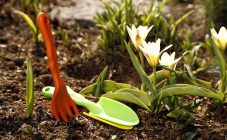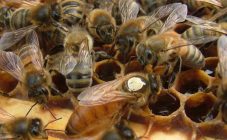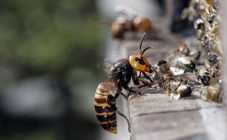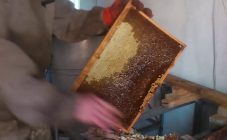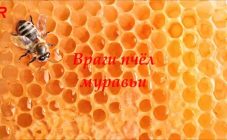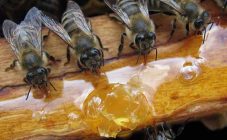Content:
Beekeeping is quite a profitable and troublesome business. The apiary requires constant care, even in winter, as bees do not have calendars. It is necessary to prepare well for the winter period so that the next year is productive. Autumn work on the apiary is carried out after the last bribe has been received.
Autumn works
The main autumn work in the apiary is carried out in three stages:
- Feeding bees;
- Tick treatment;
- Revision of bees.
Top dressing, killing of packet bees in autumn
The main goals of feeding bees for the winter are:
- Scanty stocks of existing feed;
- Replacement of spoiled or poor-quality feed;
- To maintain uterine oviposition.
The beekeeper must decide for himself how it is more convenient for him: to leave the honey until winter or pump it out all, and feed the bees in the autumn. For bees, wintering on honey would be the best option. But honey must be of a type that does not become sugar for a long time. This is determined by the peduncles from which honey was taken the last time. In any case, from the last pumped out honey, you should set aside a supply for the winter.
It happens that the printed honey is not enough. Several days were not enough for the bees to seal the honey with high quality. In this case, it is also necessary to have additional feeding, because the lack of a food base can lead to the death of packet bees.
It is also advisable to have feeding when stimulating egg-laying. But you should not get carried away with this process, since most of the bees will not go to winter, this can reduce the productivity of the next season.
Top dressing is carried out after the hive has been cleared of extra honeycombs. Feeding troughs are placed in their places. The most convenient are the ceiling options for the feeders. Instead of feeders, you can use ordinary sippy cups or bottles with holes. A small corridor for insects is left in the ceiling so that they can pick up the syrup and put it in the honeycomb. The most widely used fall feeding option is sugar syrup. One family prepares about 200 gr. syrup. It is not recommended to prepare syrup for future use, since only fresh product is used for feeding. It is allowed to add vitamins and dietary supplements to the syrup.
Tick treatment
A frequent unwanted guest in hives is the varoa mite. It has a very negative effect on bee brood. It can destroy the entire family, so every autumn the beekeeper should carry out the autumn processing of the bees and all the evidence from this species of mite. The very first sign of a tick is small bees with damaged wings. This is the initial stage of varroatosis. This is not a new disease. It has long been known in the world of beekeeping. But the previously used methods of fighting this parasite are no longer effective in our time, since it mutates and increases immunity to many poisons.
In veterinary pharmacies, you can buy drugs such as Bipin or Tactic, which should be used to treat the hives. They have an instant effect on varoa. These are the most powerful anti-tick agents to date. Formic acid and oxalic acid are also commonly used. The effect from them is not so quick. These preparations do not settle on honey, therefore they are safe enough for bees.
Bee revision
The autumn revision of bees is a very responsible matter. It begins with the termination of the main bribe.The time period in which it is recommended to start the audit is August-September. It all depends on the weather conditions. During the audit, another headache is added to the beekeeper - in the form of thief bees. It can be both your own bees and strangers. If foreign bees of a dark color have arrived at the apiary, you should strain and begin to take measures to combat them, since their invasion can destroy more than one bee family in the apiary. The most vulnerable to attack are weaker families or families without a uterus.
Before the audit itself, a number of specific actions are required:
- Dry the frames;
- Pump out honey;
- Remove shops.
The autumn audit is carried out in order to identify weak families, to detect the absence or small amount of food supply, to determine the presence of a queen that lays eggs.
Strong bee colonies are determined by the number of frames used. Those frames that are not used by bees must be removed.
During the audit, the amount of food that remains for the bees for the winter period is determined. Since it is better for insects to survive the winter on honey, it must be left in the right amount. Most often, sunflower honey or herbs are used for these purposes.
The uterus is searched for the laid eggs. For this, each frame is examined. If the inspection does not give results, a snag (a frame with laid eggs taken from another family) is placed in the center of the hive.
Bee care
For the bee wintering in the hive, there must be a necessary supply of food, the family must have a healthy young queen, and the family must be strong. All bees preparing for winter must fly around. If this is not done before the onset of cold weather, bees will die from indigestion in the stomach. The entire flight process takes some time, so the last brood should occur no later than mid-August. All other offspring are removed from evidence and destroyed.
Autumn prevention of diseases
The most common bee disease is nosematosis. Bees become infected with this intracellular parasite when they eat honey. The disease is aggravated by the presence of honeydew honey in the fodder base and prolonged wintering. Most often, the disease manifests itself at the end of winter. The main symptom of nosematosis is diarrhea. The next stage of development is the death of the family.
Treatment of bees in the fall is carried out with the drug fumagillin DCG. Its dosage is 20 ml per family. Dilute the medicine in sugar syrup. All dosages are indicated in the instructions for the drug.
Amoebiosis can be treated with the same medications used for nosematosis. A disease such as acarapidosis is cured by Tedion, Folbex, Ethersulfatonate. When treating bees in the fall, formic acid is used as preventive measures against many diseases. Formacid will help get rid of ticks, it is used in the autumn prevention of bee diseases.
Moving a hive in an apiary in summer
If you observe the bees for some time, you will notice that when the hives are taken to the apiary in the summer or the hive is moved to a new place, the bees must adapt to the new territory. Young or old bees in a new place behave the same way. Having flown out of the hive, they circle over the hive for some time, without flying away from it at great distances. Over time, the flying circles become more and more in diameter, and the bee already marks the location of the hive in the apiary. But it is worth moving the bee house literally 0.5 meters, she will no longer be able to find it. There are some rules, adhering to which you can still move the hive without losing a single bee. To do this, the entrances are closed with mosquito nets, and the hives are transferred to the basement for several days. If insects behave calmly, objects in the apiary change the position of objects.At the new place, it is recommended to arrange the evidence in the same order in which they stood before. During honey collection, it is generally forbidden to transfer the hives.
Apiary work in April, May and July
An audit is required in April. It is carried out so that the beekeeper understands the real picture of the state of the bee colonies that have endured the winter period. When identifying weak families, their build-up occurs by the period of honey collection. In April, bees are examined daily, the intensity of their flights, the time of departure and arrival in the hives are analyzed. You can try to combine very weak families. But one should not rely heavily on the fact that this association will result in a strong family.
In May, the beekeeper monitors the expansion of the bee nest. Also, the beekeeper monitors the intensity with which eggs are laid. If this process is slowed down for some reason, it must be stimulated. In May, all the bees are busy raising young animals and building new honeycombs.
The work on the apiary in July includes daily monitoring to ensure that there are empty combs in the hives. Because if this moment is missed, and the bees have nowhere to carry nectar, the beekeeper will lose bribes and will be left without high-quality honey. Also, the main duty of the beekeeper in the hottest summer month is to pump out the honey.
Owning your own apiary is a very profitable business. But you should be prepared for the fact that the maintenance of the apiary takes a lot of time and effort. If you follow the basic tips for caring for bees, even a novice beekeeper can cope with this task.





